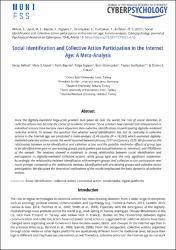| dc.contributor.author | Akfırat, Serap | |
| dc.contributor.author | Uysal, Mete Sefa | |
| dc.contributor.author | Bayrak, Fatih | |
| dc.contributor.author | Ergiyen, Tolga | |
| dc.contributor.author | Üzümçeker, Emir | |
| dc.contributor.author | Yurtbakan, Taylan | |
| dc.contributor.author | Özkan, Özlem Serap | |
| dc.date.accessioned | 2021-12-03T11:18:28Z | |
| dc.date.available | 2021-12-03T11:18:28Z | |
| dc.date.issued | 2021 | en_US |
| dc.identifier.citation | Akfırat, S., Uysal, M. S., Bayrak, F., Ergiyen, T., Üzümçeker, E., Yurtbakan, T. ... Özkan, Ö. S. (2021). Social identification and collective action participation in the internet age: A meta-analysis. Cyberpsychology-Journal of Psychosocial Research on Cyberspace, 15(4). https://dx.doi.org/10.5817/CP2021-4-10 | en_US |
| dc.identifier.issn | 1802-7962 | |
| dc.identifier.uri | https://dx.doi.org/10.5817/CP2021-4-10 | |
| dc.identifier.uri | https://hdl.handle.net/20.500.12511/8611 | |
| dc.description.abstract | Since the digitally-mediated large-scale protests took place all over the world, the role of social identities in collective actions has become the center of academic attention. Some scholars have claimed that interpersonal or individual reasons have become more important than collective identifications in participating digitally-mediated collective actions. To answer the question that whether social identification has lost its centrality in collective actions in the Internet age, we conducted a meta-analysis of 46 studies (N = 18,242) which examined digitally-mediated collective actions across the world reported between January 2011 and January 2020. We focused on the relationship between social identification and collective action, and the possible moderator effects of group type to be identified (emergent vs. pre-existing group), participation type (actual behavior vs. intention), and WEIRDness of the sample. The analyses showed a moderate to strong relationship between social identification and participation in digitally-mediated collective actions, while group type was the only significant moderator. Accordingly, the relationship between identification with emergent groups and collective action participation was much stronger compared to the relationship between identification with pre-existing groups and collective action participation. We discussed the theoretical implications of the results emphasized the basic dynamics of collective actions. | en_US |
| dc.language.iso | eng | en_US |
| dc.publisher | Masarykova Univerzita | en_US |
| dc.rights | info:eu-repo/semantics/openAccess | en_US |
| dc.rights | Attribution-NonCommercial-NoDerivatives 4.0 International | * |
| dc.rights.uri | https://creativecommons.org/licenses/by-nc-nd/4.0/ | * |
| dc.subject | Social Identification | en_US |
| dc.subject | Collective Action | en_US |
| dc.subject | Connective Action | en_US |
| dc.subject | Social Media | en_US |
| dc.subject | Digital Platforms | en_US |
| dc.title | Social identification and collective action participation in the internet age: A meta-analysis | en_US |
| dc.type | article | en_US |
| dc.relation.ispartof | Cyberpsychology-Journal of Psychosocial Research on Cyberspace | en_US |
| dc.department | İstanbul Medipol Üniversitesi, İnsan ve Toplum Bilimleri Fakültesi, Psikoloji Bölümü | en_US |
| dc.identifier.volume | 15 | en_US |
| dc.identifier.issue | 4 | en_US |
| dc.relation.publicationcategory | Makale - Uluslararası Hakemli Dergi - Kurum Öğretim Elemanı | en_US |
| dc.identifier.doi | 10.5817/CP2021-4-10 | en_US |
| dc.identifier.wosquality | Q2 | en_US |
| dc.identifier.scopusquality | Q1 | en_US |



















